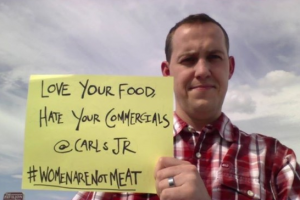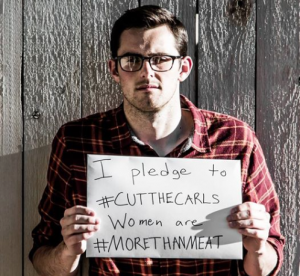Apr
2015
A Rhetorical Analysis of Carl’s Jr. Ads
Utilizing Models is the Only Way to Sell Greasy Fast-Food, Right?
By Hannah Bisbing
Setting: The sounds of Bobby Darin’s song “Somewhere Beyond the Sea” play as visuals of a beautiful young woman (played by superstar Danish model Nina Agdal) in a barely-there bikini appear. She emerges from the pristine, blue-green ocean and walks along the golden sand of an isolated tropical island. Suddenly, she appears half-lying on a beach towel with a Carl’s Jr. take-out bag and is taking a large bite out of a giant, scrumptious-looking fish sandwich. After several more seconds of extended, slow motion sandwich ravishing, the girl unties the straps of her bikini top. Continuing to eat, a sunburnt man walks up to her and says, “Nice sandwich.” She shakes her head, laughing at the man’s careless nature to allow himself to become as red as a steamed lobster, then an unseen announcer claims, “Sometimes you don’t want to get fried. The charbroiled, not fried, cod fish sandwich. Only at Carl’s Jr. and Hardee’s.”
Throughout the entirety of this commercial, I was rather confused about how extremely attractive, skinny, and essentially naked models have anything to do with food, especially fast food. The whole advertisement is absolutely ridiculous in thought and nature, whether you are discussing its chosen setting, background music, super enhanced sandwich eating sounds effects, its sandwich promoter, or the unrealistic actions that occur within it.
Examining just the behavior of this ad, educated viewers can easily see how much this ad lacks any true sense. First, the model shown is dressed quite scantily until she becomes wholly topless. She also eats the sandwich she is promoting in a far-fetched, bogus manner. What normal human being consumes a sandwich in a cat-like position on one knee, by arching backwards in a sexual manner, or while slowly spreading their legs open to reveal, well, the personal anatomy of the down-there area?
Additionally, several times during this brief advertisement, Agdal is shown spraying sunscreen all over her body without any food being in the picture. She suggestively rubs sunscreen on her chest in one segment while she sticks her butt out, rotates it around closer to the camera, and sprays protectant all over it during several other moments. Is this necessary to include in any commercial that is supposed to be promoting a chain restaurant’s food options?
However, looking back on Carl’s Jr. advertising history, this bizarre tactic is not too surprising. Most, if not all, of Carl’s Jr. ads within the past ten years or so have possessed extremely similar themes: nearly-naked famous models, unfitting sexual behavior, fancy cars, beautiful beaches, and/or bedroom shots. In previous commercials, well known names in the entertainment world like Paris Hilton, Kim Kardashian, and Kate Upton were featured, just to name a few.
Just like the Nina Agdal advertisement, all of the other ads were hyper-sexualized and utilized gorgeous, thin, sexy models to exhibit their food. Also, these women are typically wearing revealing clothing, little evidence of clothing, or no clothing at all. They each show their models eating burgers in sexual ways as well – yes, it is indeed possible – or shoving them into the mouths of gawking, star-struck males. Crawling around like an animal on all fours, showing impressive cleavage, touching their bodies, ripping at their clothes, licking drink straws, and “writhing” in expensive automobiles are all quite common.
So why does this international company feel the need to do things like this in the first place? Well, for a span of a couple years several years ago, Carl’s Jr. experienced a significant drop in sales, likely due to competition from more prominent fast food chains like McDonald’s. Seeking to attract business, to boost their popularity, and to make people remember their company’s ads (whether they wanted to or not), Carl’s Jr. marketers chose to air sexualized, interest-capturing commercials on television. In fact, the ads are so racy that several have been banned from being shown on public T.V. They are really more like soft porn rather than food promotions.
In terms of intended audience for these advertisements, the company’s executive vice president of marketing Brad Haley claims the ads are meant to target both “young, hungry guys” and “young, hungry gals.” However, the content of these commercials are clearly more appealing towards fairly young, stereotypical sexed-up males. Women typically do not enjoy seeing other members of their gender being objectified, used as sex symbols, being photo-shopped to creepy levels of perfection, or seeming to be useful only to attract men. The commercials are blatantly sexist and degrading to women, so why would females want to watch them? Unless they are suggesting to women that by eating their food they will look and feel like the people shown in the advertisements? Perhaps, but likely not.
Begging the question, why does Carl’s Jr. not include perspectives from the male side? Why does the company refuse to create ads that clearly appeal to women or that utilize men as the main models? Is it because they believe women are typically less likely to buy their food, so they just advertise to men? Perhaps it is because unhealthy food is not commonly associated with women in today’s world. Since women are apparently meant to be thin, beautiful, and obsessed with eating only healthy food to stay skinny, fast food is not included in that ideology. In fact, the company actually experienced major controversy when they aired an X-men themed commercial that basically implied that women are not meant/able to “handle its meaty burgers.”
Also, the company might believe that showing males in the same sexual manner as the women in these ads actually might make men less likely to buy food at Carl’s Jr. Men seeing other men doing bizarre, inappropriately sexual things on television typically just makes guys uncomfortable, not willing to run to the drive-thru. How sexist and ethically/logically flawed is that?
To get the real audience they are reaching out towards, Carl’s Jr. marketing purposefully objectifies women as food and includes typical bro interests, like cars, burgers, bars, and – of course – hot, nearly naked girls. Sex sells, and this company certainly realizes that.
Interestingly enough, these particular advertisements are often shown on television late at night, on sports channels, and during the Super Bowl. Acknowledging the desired viewers (males from teens to middle age) and that food and sex are the main focuses, choosing these time slots does not seem coincidental in the least. In general, nighttime T.V. is often more sexual in nature since children are usually in bed by then and only adults are watching. Plus, night is typically just a sexually active/conducive time anyway. Also, it is important to realize that as the night continues, dinners have been digested. Seeing food onscreen stimulates the hunger-inducing cells of our brains, making people more likely to go out and buy food that they see shown on television. Advertising tactics always seek to reach the largest audience and to utilize the most effective, most widely shared psychological connections amongst their viewers.
This leads to the acknowledgement that Carl’s Jr. is absolutely not civic in its business actions and motives. Just like any other company that advertises, they are obviously trying to sell their products, but they are doing it incredibly immoral ways that are not even slightly reminiscent of what they are actually selling. This food chain is simply trying to gather attention to itself, and it has certainly worked/is still working in regards to recent outbursts about the inappropriate sexual nature of these ads. Additionally, Carl’s Jr. does not seem to give the slimmest care what kind of attention they are receiving as long as they are getting attention in the first place.
Concluding this argument is a statement that perfectly epitomizes the immoral and rhetorically befuddling advertising tactics at hand. According to New York Daily News regarding both this commercial and Carl’s Jr. modern popularity levels, “What burger? Nina Agdal is the reason why millions will want to eat at Carl Jr.’s.”
Further reading:
http://abcnews.go.com/Business/story?id=893867
http://www.latimes.com/food/dailydish/la-dd-carls-jr-women-cant-handle-burgers-20140409-story.html
http://money.cnn.com/2005/05/24/news/newsmakers/carls_ad/
http://universe.byu.edu/2014/09/17/carls-jr-facing-criticism-for-ads-again/
Sources:
http://girltalkhq.com/non-profit-tells-carls-jr-cut-crap-sexist-commercials/
http://www.huffingtonpost.com/2014/07/25/paris-hilton-carls-jr-commercial_n_5621747.html
http://jezebel.com/5990397/put-it-in-my-mouth-a-history-of-disgusting-carls-jr-ads
http://www.nydailynews.com/entertainment/nina-agdal-stars-carl-jr-s-super-bowl-ad-article-1.1255619



